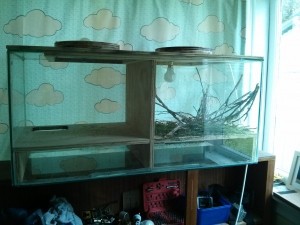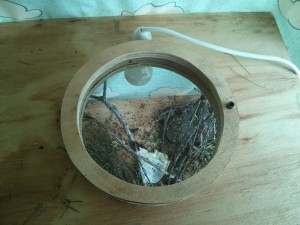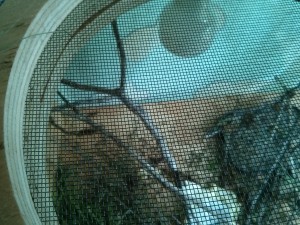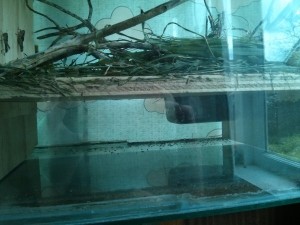As I’ve mentioned previously, this is a trial and error type project – I’m adapting my design as I go to optimise the locusts’ home and encourage successful breeding. So far I’ve lost three out of thirty locusts, but the main population appear robust so I’m hoping they’ll reach full maturity.
I’ve got my basic breeding information from various sources, most of which focus on keeping locusts for reptile food. There’s not a lot out there for people who are breeding insects to eat themselves, mostly because of the ‘ick’ factor, but I think there’s something pretty neat in farming your own sustainable source of high quality protein.
Here’s the complete set-up – I’m only using the compartment on the right side presently (the left will become the nursery).
Here you can see a few locusts on the wooden partition, the placement of the light and the hatch which rotates open for access to the tank:
More detail on the hatch/mesh – in the top photo you can see where it pivots:
Choosing wood and glass has helped to cut down on humidity inside the tank, although you can use a large plastic bin – the big storage ones with lids are very easy to set up and you can drill small holes instead of using mesh.
Here’s a close-up of the raised floor – you can see the little tub of sand at the back.
I need to create a mini brush/dustpan that I can use with one hand to clean the floor of the tank without disturbing the locusts overly much. Although with a six-eight week rotation (locusts only live around two months) from birth to breeding to harvest, I may be able to clean out each tank properly in between generations.
I’ve deliberately purchased younger locusts so that I have time to adjust their habitat before they start mating and breeding. At the moment I have several vertical sticks covering the sand pit because it’s not being used – I’ll have to move things around once I have an adult pair of locusts.
Here are a few of the sources I’ve used to create my breeding set-up:
http://www.e-learning.net.nz/tuatara/breeding.html
http://www.pras-uk.co.uk/breedinglocusts.htm
http://www.easyinsects.co.uk/livefood/locusts/index.html
I’ve also researched locusts/breeding using the following books (from Auckland Library):
Stone, John L. S. Keeping & Breeding Butterflies and Other Exotica: Praying Mantis, Scorpions, Stick Insects, Leaf Insects, Locusts, Large Spiders, and Leaf-cutter Ants. London: Blandford, 1992.
Parkinson, Brian. A Photographic Guide to Insects of New Zealand. Auckland: New Holland, 2007.
Early, John. Know Your New Zealand Insects and Spiders. Auckland: New Holland, 2009.
Crowe, Andrew. Which New Zealand Insect?: With over 650 Life-size Photos of New Zealand Insects. Auckland, N.Z.: Penguin, 2002.
Walters, Martin. The Illustrated World Encyclopedia of Insects: A Natural History and Identification Guide to Beetles, Flies, Bees, Wasps, Mayflies, Dragonflies, Cockroaches, Mantids, Earwigs, Ants and Many More. London: Lorenz, 2008. Print.





